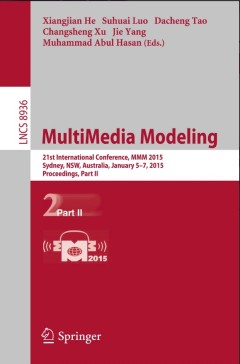Filter by

Multimedia Data Mining and Analytics
This book provides fresh insights into the cutting edge of multimedia data mining, reflecting how the research focus has shifted towards networked social communities, mobile devices and sensors. The work describes how the history of multimedia data processing can be viewed as a sequence of disruptive innovations. Across the chapters, the discussion covers the practical frameworks, libraries, an…
- Edition
- 1
- ISBN/ISSN
- 978-3-319-14997-4
- Collation
- XIV, 454
- Series Title
- -
- Call Number
- -

Emotional Feedback for Mobile Devices
This book investigates the functional adequacy as well as the affective impression made by feedback messages on mobile devices. It presents an easily adoptable experimental setup to examine context effects on various feedback messages and applies it to auditory, tactile and auditory-tactile feedback messages. This approach provides insights into the relationship between the affective impression…
- Edition
- -
- ISBN/ISSN
- 978-3-319-17193-7
- Collation
- 16 b/w illustrations, 13 illustrations in colour
- Series Title
- -
- Call Number
- -

MultiMedia Modeling
The two-volume set LNCS 8935 and 8936 constitutes the thoroughly refereed proceedings of the 21st International Conference on Multimedia Modeling, MMM 2015, held in Sydney, Australia, in January 2015. The 49 revised regular papers, 24 poster presentations, were carefully reviewed and selected from 189 submissions. For the three special session, a total of 18 papers were accepted for MMM 2015. T…
- Edition
- 1
- ISBN/ISSN
- 1611-3349
- Collation
- XXII, 586
- Series Title
- Lecture Notes in Computer Science
- Call Number
- -

Modern Stroke Rehabilitation through e-Health-based Entertainment
This book describes a new, “e-Health” approach to stroke rehabilitation. The authors propose an alternative approach that combines state of the art ICT technologies ranging from Augmented and Virtual Reality gaming environments to latest advances in immersive user interfaces for delivering a mixed-reality training platform, along with advanced embedded micro sensing and computing devices e…
- Edition
- 1
- ISBN/ISSN
- 978-3-319-21292-0
- Collation
- IX, 324
- Series Title
- -
- Call Number
- -

The Shaping of Ambient Intelligence and the Internet of Things
Recent advances in ICT have given rise to new socially disruptive technologies: AmI and the IoT, marking a major technological change which may lead to a drastic transformation of the technological ecosystem in all its complexity, as well as to a major alteration in technology use and thus daily living. Yet no work has systematically explored AmI and the IoT as advances in science and technolog…
- Edition
- -
- ISBN/ISSN
- 978-94-6239-142-0
- Collation
- -
- Series Title
- -
- Call Number
- -

Hybrid Museum Experiences Theory and Design
"So you’re the one getting this gift? Lucky you! Someone who knows you has visited the museum. They searched out things they thought you would care about, and they took photos and left messages for you." This is the welcoming message for the Gift app, designed to create a very personal museum visit. Hybrid Museum Experiences use new technologies to augment, expand or alter the physical experi…
- Edition
- -
- ISBN/ISSN
- 9789048552849
- Collation
- -
- Series Title
- -
- Call Number
- -

Game Production Studies
Video games have entered the cultural mainstream and in terms of economic profits they now rival established entertainment industries such as film or television. As careers in video game development become more common, so do the stories about precarious working conditions and structural inequalities within the industry. Yet, scholars have largely overlooked video game production cultures in fav…
- Edition
- -
- ISBN/ISSN
- 9789048551736
- Collation
- -
- Series Title
- -
- Call Number
- -

Geografi dan geografi media yang dimediasi
Susan P. Mains adalah Dosen Geografi Manusia di Universitas Dundee. Karyanya mengeksplorasi identitas transnasional dan representasi media tentang mobilitas, perbatasan, dan keamanan dalam konteks migrasi Karibia, industri kreatif di Jamaika dan Skotlandia, dan pariwisata warisan. Dia telah menerbitkan di berbagai jurnal internasional termasuk Geografi Sosial dan Budaya, GeoJournal, Journal of …
- Edition
- 1
- ISBN/ISSN
- 978-94-017-9968-3
- Collation
- IX, 470
- Series Title
- -
- Call Number
- -

The Trump Presidency, Journalism, and Democracy
This book examines the disruptive nature of Trump news – both the news his administration makes and the coverage of it – related to dominant paradigms and ideologies of U.S. journalism. By relying on conceptualizations of media memory and "othering" through news coverage that enhances socio-conservative positions on issues such as immigration, the book positions this moment in a time of con…
- Edition
- -
- ISBN/ISSN
- 9781351392020
- Collation
- -
- Series Title
- -
- Call Number
- 070.449304 TRU t

Solidarity in the Media and Public Contention over Refugees in Europe
This book examines the ‘European refugee crisis’, offering an in-depth comparative analysis of how public attitudes towards refugees and humanitarian dispositions are shaped by political news coverage. An international team of authors address the role of the media in contesting solidarity towards refugees from a variety of disciplinary perspectives. Focusing on the public sphere, t…
- Edition
- -
- ISBN/ISSN
- 9781000370485
- Collation
- -
- Series Title
- -
- Call Number
- 302.23 SOL s
 Computer Science, Information & General Works
Computer Science, Information & General Works  Philosophy & Psychology
Philosophy & Psychology  Religion
Religion  Social Sciences
Social Sciences  Language
Language  Pure Science
Pure Science  Applied Sciences
Applied Sciences  Art & Recreation
Art & Recreation  Literature
Literature  History & Geography
History & Geography